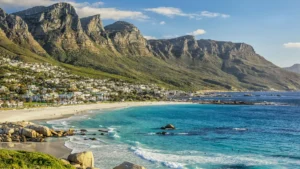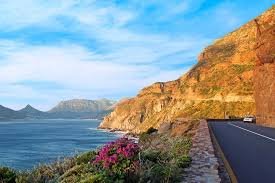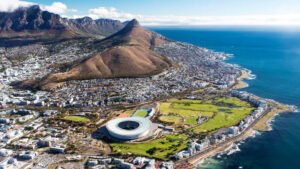


South Africa is not merely a collection of destinations — it is an archive of landscapes, climate zones, biodiversity, and human histories layered one atop another. The best places to visit in South Africa are those where you can see the collisions of tectonics, the flow of rivers, the migrations of animals, and the chronicles of people striving for identity. To travel there is to read the land like a text.
In what follows, each place is chosen not just for its beauty, but for the voice it adds to that national conversation — where earth, plants, animals, and people intersect.
Cape Town and the Cape Peninsula: where sea, rock, and city converse
Table Mountain — a rooftop over the sea
Table Mountain, with its iconic flat top, is the sentinel over Cape Town. Standing at about 1,085 m (3,560 ft), the mountain is a geological marvel — sandstone and shale layers tilted and eroded over millions of years. Wikipedia
More than a scenic backdrop, it’s a living museum of fynbos (a unique shrubland biome), with around 8,200 plant species, many endemic. Wikipedia Riding the cable car to the top or hiking up Platteklip Gorge, you hear wind, watch clouds forming, and glimpse Cape Town’s expanse below. The mountain literally speaks — rock, flora, and climate telling stories of deep time.
Cape Peninsula, Cape of Good Hope & Boulders Beach
Drive down Chapman’s Peak or the winding coastal road to the Cape Peninsula and you traverse cliff edges, wind-swept coves, and biodiversity zones. Cape Point and the Cape of Good Hope are places where Atlantic and Indian Oceans meet — currents converge, ecosystems blend. Full Suitcase Travel Blog+1
At Boulders Beach, you’ll find an unexpected delight: African penguins waddling among granite boulders. It’s a reminder that even in rugged terrain, life persists in odd niches. Tripadvisor+1
Robben Island, visible offshore, is another anchor in this narrative — a site of political struggle where Nelson Mandela was imprisoned. It links the geology of the Cape with the human history of resistance.
The Garden Route & Knysna: forest, shoreline, interplay
The Garden Route stretches roughly 200 km between Mossel Bay and Storms River, weaving coastlines, lagoons, indigenous forests, and charming towns. Go2Africa+1 Driving its curves is a journey through several micro-ecosystems: dune forests, wetlands, coastal heath, and rivers carving cliffs.
Knysna & the Knysna Heads
Knysna is famed for its estuary and the twin cliffs known as the “Heads,” guarding the entrance from the Indian Ocean. The interplay of tidal forces, storms, and sediment capture is visible in how the estuary shifts with time. Full Suitcase Travel Blog+1
On nearby land, you find Featherbed Nature Reserve, or join boat cruises to observe the forest meeting sea. This is one of those best places to visit in South Africa where you sense the slow dialogue between forest, rock, and wave.
Tsitsikamma National Park
Part of the Garden Route, Tsitsikamma means “place of abundant water” in Khoekhoe. Rivers cut through ancient sandstone, forests drape the slopes, and suspension bridges span gorges. You cross a canopy walkway over Otter Gorge — nature speaking in continuously shifting voices of wind, leaf, river, and rock. Full Suitcase Travel Blog
Kruger National Park & the Panorama Route: where wilderness casts its voice
Kruger National Park
Perhaps the most iconic of all, Kruger National Park embodies the communion between life and land. One of South Africa’s largest and oldest protected areas, it hosts the “Big Five” — lion, leopard, elephant, buffalo, and rhino — among hundreds of other species. Go2Africa+1
To visit Kruger is to listen: dawn and dusk bring roars and calls, waterholes whisper through herds, termite mounds punctuate plains, and the tracks in mud tell of nocturnal prowlers. It is among the best places to visit in South Africa for wildlife immersion and primal connection to nature.
Panorama Route & Blyde River Canyon
Adjacent to Kruger, the Panorama Route and Blyde River Canyon elevate your sensory experience. Sheer sandstone cliffs, verdant slopes, waterfalls, and the famous “Three Rondavels” peaks distill the grandeur of earth’s sculpting forces. Full Suitcase Travel Blog+1
The Blyde River Canyon is among the largest green canyons in the world; its environment is lush, steep, and dramatic. Scenic viewpoints like God’s Window, Bourke’s Luck Potholes, and the Lisbon Falls affirm that here the earth speaks in vertical layers and flowing curves.
KwaZulu-Natal: coast, history, and indigenous landscapes
Hluhluwe–iMfolozi Park
In KwaZulu-Natal lies Hluhluwe–iMfolozi Park, the oldest game reserve in Africa. It is home to healthy populations of the Big Five and especially known for its white rhino conservation successes. Wikipedia
Its rolling hills, river valleys, and savanna forests offer experiences where animals move freely and rivers mark boundaries. The reserve speaks of conservation, struggle, and recovery in a landscape long challenged by human pressures.
Sodwana Bay & iSimangaliso Wetlands
On the coast, Sodwana Bay and the iSimangaliso Wetland Park offer another dimension of voice — marine. Sodwana is South Africa’s premier dive site: coral reefs teem with tropical fish, whale sharks and turtles visit seasonally. Wikipedia
The adjacent iSimangaliso region (a UNESCO World Heritage site) combines wetlands, dunes, coastal forests, and marine zones. It is a place where rivers flow into estuaries, and salt and fresh waters mix — a liminal zone full of life and complexity.
Namaqua National Park: the spring cathedral of flowers
In the arid northwestern stretch of the Northern Cape lies Namaqua National Park. What seems like desert for much of the year transforms in spring into one of the most spectacular botanical displays on Earth: carpets of wildflowers bursting into bloom across the landscape. Wikipedia
This is a place where the land speaks softly but powerfully via blossoms — hues of yellow, purple, pink, red — reminding us that even in scarcity, life persists. During August and September, the park draws botanists, photographers, and travelers seeking astonishment. It’s one of the best places to visit in South Africa for those attuned to nature’s seasonal whispers.
Johannesburg & Soweto: urban memory inscribed on streets
Natural landscapes speak loudly, but so do cities — especially one like Johannesburg, whose very streets bear the imprints of struggle, gold rush ambition, segregation, and rebirth. Among its cultural landmarks:
-
Apartheid Museum and Constitution Hill: Sites that chronicle the struggle, incarceration, and eventual constitutional rebirth.
-
Soweto tour: A guided walk through township life, with visits to Mandela House and areas that witnessed the 1976 uprisings.
-
Maboneng Precinct: A regenerated arts and cultural district, where street art, galleries, cafés, and community initiatives reflect a contemporary voice. Vogue+1
Here, the earth plays a quieter role — beneath roads lie gold seams, and neighborhoods grew under shifting economic forces. But it is human memory, embodied in concrete and murals, that speaks the loudest here.
Integrating landscapes, history & further research
If you follow this map of the best places to visit in South Africa, the journey becomes a layering of geological epochs, ecosystems, and human stories. But to deepen your understanding, you might ask:
-
How have tectonic movements shaped the Drakensberg and the Cape mountains?
-
What are the evolutionary histories of fynbos and the Succulent Karoo (e.g. Namaqua)?
-
How did colonial settlement, apartheid, and post-apartheid policies shape land use, conservation, and urban expansion?
-
What role have indigenous knowledge systems played in land management across different biomes?
For comparative insight, you might also explore similar deep-landscape narratives in other countries — for example, check the best places to visit in Morocco to see how deserts, mountains, and histories cross continents in speaking their own geographical languages.
Practical tips & rhythms of travel
-
Timing matters — The dry winter (May to September) is ideal for wildlife viewing in Kruger. Spring (August–September) is the time for Namaqua’s wildflower emissions. Cape and Garden Route are best in mild seasons like September–November or March–May.
-
Travel slowly — Some of the land’s stories only unfold when you pause: a rainforest understory in Tsitsikamma, the silent dawn in Kruger, a coastal sunrise at Sodwana.
-
Guide with intention — Use local guides to understand the ecology, local languages, and cultural history. Their knowledge lets the land and its people speak more clearly.
-
Respect the land — Follow park rules, stay on trails, and don’t disturb vegetation and wildlife. Many of these ecosystems (fynbos, Succulent Karoo) are delicate.
-
Layer your itinerary — Combine coastal, inland, mountainous, and urban sites to appreciate South Africa’s diversity fully. For example: Cape Town → Garden Route → Kruger → KwaZulu-Natal → Namaqua → Johannesburg.
Conclusion: hearing the earth speak
When you visit the best places to visit in South Africa, you are not merely seeing pretty vistas — you are conversing with time. Table Mountain speaks of shifting continents; wildflowers in Namaqua speak of persistence in scarcity; Savannahs in Kruger converse in predator and prey; urban precincts in Johannesburg echo political and human struggle.
If you travel with curiosity, patience, and respect, you’ll perceive that in South Africa, earth and history are not separated — they are entwined in voice, memory, and living matter. May your next journey there leave you changed, attuned not only to what is seen, but to what is heard from within the land.


